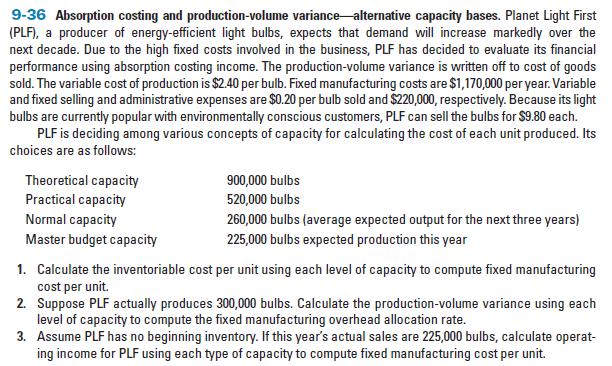9-36 Absorption costing and production-volume variance alternative capacity bases. Planet Light First (PLF), a producer of energy-efficient light bulbs, expects that demand will increase markedly over the next decade. Due to the high fixed costs involved in the business, PLF has decided to evaluate its financial performance using absorption costing income. The production-volume variance is written off to cost of goods sold. The variable cost of production is $2.40 per bulb. Fixed manufacturing costs are $1,170,000 per year. Variable and fixed selling and administrative expenses are $0.20 per bulb sold and $220,000, respectively. Because its light bulbs are currently popular with environmentally conscious customers, PLF can sell the bulbs for $9.80 each. PLF is deciding among various concepts of capacity for calculating the cost of each unit produced. Its choices are as follows: Theoretical capacity Practical capacity 900,000 bulbs 520,000 bulbs Normal capacity 260,000 bulbs (average expected output for the next three years) 225,000 bulbs expected production this year Master budget capacity 1. Calculate the inventoriable cost per unit using each level of capacity to compute fixed manufacturing cost per unit. 2. Suppose PLF actually produces 300,000 bulbs. Calculate the production-volume variance using each level of capacity to compute the fixed manufacturing overhead allocation rate. 3. Assume PLF has no beginning inventory. If this year's actual sales are 225,000 bulbs, calculate operat- ing income for PLF using each type of capacity to compute fixed manufacturing cost per unit.
Operating income effects of denominator-level choice and disposal of production-volume variance (continuation of 9-36). 1. If PLF sells all 300,000 bulbs produced, what would be the effect on operating income of using each type of capacity as a basis for calculating

Trending now
This is a popular solution!
Step by step
Solved in 7 steps with 7 images









